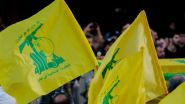
When you browse X, it feels as though a civil war is unfolding between Hezbollah supporters and the rest of the Lebanese population. The sentiment among ordinary Lebanese citizens echoes the days when the PLO attempted to dominate the country, acting as an entitled bully under the guise of their cause. There is growing frustration with Hezbollah’s policies and the behavior of their supporters on social media. This has provoked a response from far-right radicals, trapping the nation in a relentless cycle of hate.
Hezbollah and Iran have effectively used propaganda and religious ideology to solidify their influence and control over their supporters. By framing their political and military actions within a narrative of religious duty and resistance, they tap into deep-seated religious beliefs and cultural identity.
This religious framing allows them to justify their actions as part of a divine struggle, or "jihad," against perceived enemies.
Through media channels, religious sermons, and symbolic events like Ashura, they disseminate messages that blend religious fervor with political ideology, ensuring loyalty among their base and creating a powerful sense of identity and purpose among their followers. This combination of propaganda and religion not only mobilizes support but also suppresses dissent, as opposing their narrative can be seen as opposing their religious and cultural values. Anyone who disagrees with them or prefers to be loyal to the Lebanese cause rather than any other cause is labeled as a "Zionist.”
Echoes of History: Lessons from the Rise and Fall of Militant Groups
The allure of power has long been a driving force for militant groups, propelling them from the fringes of society to positions of influence and control. However, this ascent often breeds a dangerous sense of invincibility, both among the groups themselves and their fervent supporters. Fueled by ideological zeal and military successes, these groups frequently embark on a power trip, believing themselves immune to the forces that have historically led to the downfall of other similar movements.
Yet, history shows that this very ego and overconfidence can be their undoing. From the Taliban in Afghanistan to the Tamil Tigers in Sri Lanka, many militant groups have fallen not solely due to external pressures but because their inflated sense of power blinds them to the realities of their vulnerabilities. Let’s explore how the intoxicating mix of power, ideology, and ego drives militant groups towards their demise.
Throughout history, many ideological militant groups have risen to prominence, only to eventually fall due to a combination of internal and external pressures. These groups, driven by political, religious, or social ideologies, often sustain themselves through a mix of popular support, external funding, and a clear, often militant, agenda. However, their eventual decline is usually marked by several key signs, which may also apply to Hezbollah.
One prominent example is the Irish Republican Army (IRA), which sought to end British rule in Northern Ireland and unify Ireland. The IRA maintained a prolonged campaign of violence for much of the 20th century, deeply rooted in nationalist and anti-colonial ideology. However, over time, the group faced internal divisions, loss of public support, and pressure from both the British and Irish governments. The eventual signing of the Good Friday Agreement in 1998 marked the beginning of the end for the IRA as a militant force, as many of its objectives were addressed through political channels, leading to its demilitarization and the cessation of its violent activities.
Similarly, the Tamil Tigers (LTTE) in Sri Lanka, an ethnic separatist group, waged a violent campaign for an independent Tamil state. The group was notorious for its use of suicide bombings and other forms of terrorism. However, the LTTE faced increasing military pressure from the Sri Lankan government, coupled with dwindling international support due to its extremist tactics. By 2009, the LTTE was militarily defeated, leading to its disbandment and the end of its militant activities.
Several symptoms typically signal the impending decline of militant groups:
- Loss of External Support: Many militant groups rely heavily on foreign funding and weapons. The loss of such support, often due to shifts in international alliances or sanctions, can cripple their operational capacity.
- Internal Divisions: Ideological groups often splinter over disagreements about strategy, leadership, or ideological purity. Such divisions weaken the group from within, making it less effective in pursuing its goals.
- Diminished Popular Support: A militant group's survival often depends on its ability to maintain popular support among the local population. When its actions lead to widespread suffering or if it is perceived as prioritizing external interests over local needs, support can erode rapidly.
- Counterinsurgency efforts can severely disrupt Hezbollah's operations, but they are unlikely to eliminate them entirely. The group's power has proven to be exceedingly difficult to fully dismantle.
Hezbollah’s Path Ahead: Navigating Uncertain Terrain
Hezbollah, which emerged in the 1980s as a resistance movement against Israeli occupation in Lebanon, has evolved into a powerful political and military force in the region. They are the Iranian 'Wagner' version.
However, it shares several characteristics with other ideological militant groups that have fallen in the past.
Dependency on Iran: Hezbollah's military and financial strength are closely tied to Iranian support. Iran’s economic struggles and international isolation, exacerbated by sanctions and internal unrest, could reduce its ability to sustain Hezbollah's operations indefinitely.
Internal and External Pressures: Lebanon’s ongoing economic crisis, coupled with growing dissatisfaction among the Lebanese population, has put Hezbollah under significant pressure. Widespread protests in 2019 and the aftermath of the 2020 Beirut explosion highlighted growing discontent with Hezbollah’s political influence. Furthermore, international sanctions targeting Hezbollah's financial networks have further strained its capabilities.
Predicting Hezbollah's future is complex. While the signs of decline seen in other militant groups are present, Hezbollah has shown remarkable resilience. Its deep integration into Lebanese society, both politically and socially, gives it a stronger foundation than many other militant groups.
However, if Iran’s influence in the region wanes or if internal divisions within Hezbollah grow, the group could face significant challenges. A combination of sustained internal and external pressures might eventually lead to Hezbollah's decline or force it to transition into a purely political entity, much like the IRA.
Hezbollah currently remains a powerful force, yet the historical patterns of decline seen in other ideological militant groups suggest that its long-term survival is not guaranteed. The group's future will likely depend on its ability to adapt to changing regional dynamics and maintain its base of support in an increasingly volatile environment. In this current war, all parties will lose. Even if they claim victory, it’s obvious that Israel and Iran’s proxies are fighting for their existence, and in 18 months or so, either Israel or Iran will have the upper hand, but it’s unlikely that the US will let Israel fail.
Eventually, a big settlement will be necessary for their survival, and dismantling proxy militias will be a key element to future peace talks. The world, including western governments, is tired of the Middle East. The Obama doctrine of supporting Iran and its proxies died after the 7th of October, and even Israel is becoming a burden. Therefore, the future of the region cannot be drawn with the same players anymore.
Read more




Comments